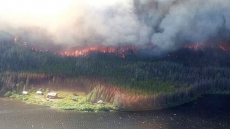The experimental Ebola drug ZMapp was able to save monkeys even when treatment was started five days after the animals were infected, when some were suffering from advanced disease, a new study shows.
This is the first research to demonstrate that an Ebola therapy could save primates if given so late in the course of their illness — a circumstance that more closely reflects how an Ebola drug would be used in an outbreak than any other study conducted to date.
It also reveals for the first time that the work to create the drug known as ZMapp was done at the Public Health Agency of Canada's National Microbiology Laboratory in Winnipeg.
The co-director of an international consortium working to develop antibody cocktails against viruses — ZMapp is one — called the results extremely promising.
"It provides a lot of hope that therapies will soon be available to be used where they are desperately needed," Erica Ollmann Saphire, co-director of the Global Virus Network Center of Excellence at Scripps Research Institute in La Jolla, Calif., said via email.
Ollmann Saphire was not directly involved in the research, but the scientists who were are part of her consortium.
The study is published online Friday in the journal Nature. The senior author of the work is Dr. Gary Kobinger, head of special pathogens research at the Winnipeg lab.
The compound is a cocktail of three monoclonal antibodies — proteins made by the immune system that target specific sites on the Ebola virus. ZMapp is a hybrid of two earlier monoclonal cocktails, one made by Kobinger's team and the other by scientists at the U.S. Army Medical Research Institute of Infectious Diseases in Frederick, Md.
About eight months ago, with the agreement of the U.S. scientists, Kobinger's team set out to produce a cocktail containing the best antibodies of the two precursors' formulations. That became ZMapp.
"We of course expected an improvement. We were at least hoping for it. But the level of improvement was at least beyond my own expectations," he said in a teleconference Friday.
"I was quite surprised that by extracting the best combination of all six we would be going as far and able to this time rescue (the monkeys) out to Day 5 — and all of them."
The treatment saved 18 monkeys that had been given what would have been a lethal dose of Ebola virus. Six each began treatment on Day 3, Day 4 and Day 5.
Scientists have been working for years on vaccines and drugs to prevent or treat Ebola. A number hold significant promise. But most of the work to date has focused on giving the therapy shortly after monkeys are injected with Ebola virus.
That scenario mirrors what would happen in humans if there is a laboratory accident involving Ebola, or if a health-care worker had a dangerous exposure treating a known Ebola patient. But in the real world setting of Ebola outbreaks, people don't know they are infected for days because symptoms are slow to set in. It's only then that they seek care — if they do at all.
"Early studies were relatively artificial and oriented more towards laboratory accidents where you injected a monkey with a bunch of Ebola virus and then 30 minutes later you gave it a vaccine or a compound. And of course it has very little replicating virus so it's not that hard at that point to inactivate that," explained Dr. Daniel Bausch, an Ebola expert at Tulane University School of Public Health and Tropical Medicine in New Orleans, La.
"And so this is the study so far when they've been able to push it out to the farthest time point when an animal is sick and has a high level of viremia (virus in the blood). ... And so that's a very promising result."
How promising?
"The simplest way I can put it is — and it's not said lightly — but if I had Ebola and someone had ZMapp I would say, 'Give it to me,'" Bausch said.
There is hope that if the drug works in people that it could be useful even later in the disease course. In primate studies the animals are given big injections of Ebola virus and they typically die around Day 8 after infection. It's thought people aren't generally exposed to such large doses of virus and death in fatal human cases is later, around Day 12 or 14.
That suggests the drug might be useful in some patients as late as Day 9 to Day 11, Kobinger said, but he noted there is a "point of no return" after which no drug will help.
Bausch also believes the primate research points to a longer treatment window in people.
"The way these experiments are done is really staking the cards against you, if you will. And so that makes any positive result perhaps all that much more promising," he said. "We probably have a little more time in a human who's getting less of a dose of Ebola."
The antibodies in the drug target the Ebola Zaire virus, which is responsible for the current large outbreak in West Africa. The other Ebola serotypes that cause human outbreaks — Ebola Sudan and Ebola Bundibugyo — would need their own targeted antibody cocktails.
But even within the Ebola Zaire subtype, there is variation among viruses. The work was done using a virus from the first Ebola outbreak, in 1976, at Kitwit, Zaire (now the Democratic Republic of Zaire). The virus spreading in West Africa is a slightly different Ebola Zaire.
Still, Kobinger said there are preliminary data showing the difference between the two viruses doesn't erode the drug's efficacy. "It performed at least as well, if not better, in vivo," he said, though that work was not outlined in the study and he did not specify which animal model was used in this early testing.
The work continues, Kobinger said. His group wants to see if the drug will save primates if given at Day 6 or Day 7. As well, they want to see if they can reduce the size of the doses, to get the maximum benefit from the least amount of drug per infection.
That would be a bonus for a drug that is in much demand but currently no supply. Kobinger said at one point there were 10 or 12 treatment courses of ZMapp, but some of the drug was used in the animal studies and some doses were given under emergency use provisions to seven people who have been infected with Ebola in the West African outbreak.
Two of those people succumbed to their infections anyway. At least one of the two, a Spanish priest, only received the first of three doses in the treatment course before he died.
Kobinger said he believes 20 to 40 doses of the drug can be made in a month, when production is up and running. The antibodies are grown in tobacco plants and work is underway to see if additional production capacity exists.
Kobinger said a Phase 1 clinical trial — which is designed to show the drug is safe for use in humans and to try to establish the necessary dose — will begin in early 2015. That work will be led by Mapp BioPharmaceuticals, which has licensed the drug and will push it through the regulatory process.
The research was financed by the U.S. Defense Threat Reduction Agency, the U.S. National Institutes of Health, the Public Health Agency of Canada and a Canadian Safety and Security Program grant to Kobinger and first author Xiangguo Qiu.





